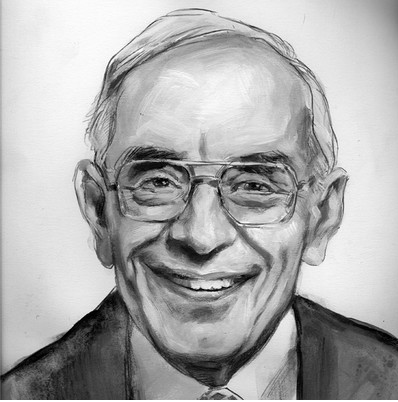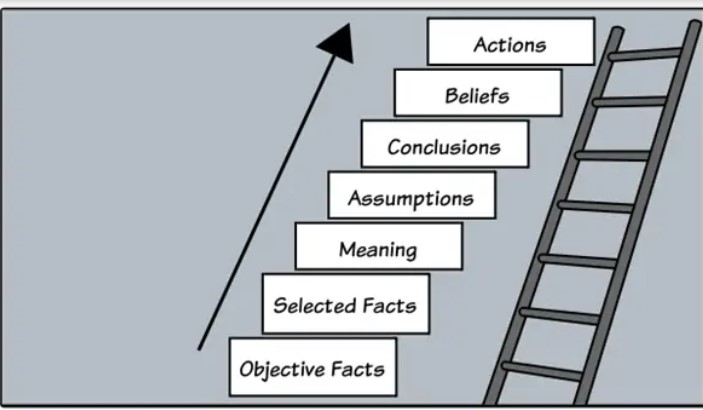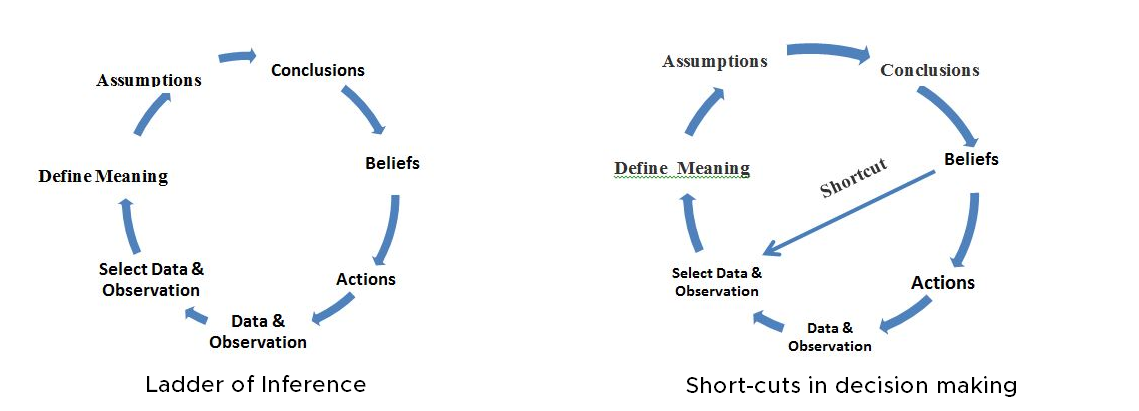
A discussion with my 9-year-old had me stumped. The discussion was ‘what protective gear was absolutely necessary while skating’. We decided to use data to make a decision. We both climbed to different conclusions using the same data! I wondered if i had missed a step in the decision-making process? Turns out decision making does involve steps and missing a step can be injurious! Let us explore assumptions through the ladder of inference which help us and our teams get better at decision making.
Origins of the ladder of inference
Chris Argyris, a Harvard professor created the ladder of inference. He was on an endeavour to discover ways of learning that produces change. Not superficial change but one that helps us explore our values and assumptions, to create sustainable change. Chris Argyris created the ladder when he was surprised that people looking at the same data were making different decisions. Much like, what protective gear to wear while skating discussion drew me to the ladder of inference.


It’s not easy to alter engrained behavior even when that behavior is clearly counterproductive — but, fortunately for the health of our organizations, it is possible.
Chris Argyris
Ladder of inference and skating gear
Here is how it played out. We both could not agree on what protective gear was necessary and important while skating. To resolve this we decided to watch videos of what professional skaters wore, to make our decision. We even selected and watched the same videos. So far so good. But it unraveled from there. The 9-year-old concluded that only the helmet would suffice. While i concluded that other elbow/palm guards were worn too and important!
How did we look at the same video(data) and draw different conclusions? Because, we selected different data points from what we were seeing and we interpreted it differently. We added our own needs and beliefs to the data to make a decision.
I had added my need of safety to draw my conclusion that other protective gear was worn (in the video) and necessary. My daughter added her need to blend in (her friends were not wearing protective gear) and chose to go with one skater (data point) who was only wearing a helmet.
Debating our conclusions without being aware of how and why we made our decisions is futile. We see this scenario play out in many ways at the workplace.
- Disagreements with the targets based on the same market trend report.
- Different conclusions about the approach after a common debrief of the situation.
- Walking out of an employee townhall with different interpretations about what was shared.
Why does this happen?
It turns out that we climb the ladder of inference so quickly, that we do not even realise we have. What is more some steps are so intuitive that we are not aware of having skipped them. These steps are closely linked to our beliefs and emotions, making it harder to spot and manage.

Even more surprisingly, we are surprised that people can people can interpret the same data differently. We assume that people around us share or must share our world view.
What makes skipping the steps in the ladder of inference and decisions that much riskier? It is the fact that the more times we skip the steps, the stronger our beliefs get. The stronger they get, the more selectively we chose data to support our beliefs. Talk of a vicious cycle.

How can we use the ladder of inference better?
Here are three ways to leverage the ladder of inference in your decision making:
1. Retrace your steps in the ladder.
We climb the ladder very quickly. The approach to better decision making is to retrace your steps to the bottom of the ladder. Discussing or writing down the steps you followed to make the decision is helpful. Here are a few resources to do just that!
2. Compare assumptions and not conclusions.
Leaders often debate the conclusions that were drawn. A better use of time is to clarify what assumptions were made to draw the conclusions. This will help spot synergy and gap more easily, and lend itself to a constructive discussion.
3. Be curious.
Ask yourself often about what else might be true in the situation. Be open and curious to possibilities.
Awareness precedes change. By having an awareness of the ladder of inference we give ourselves an opportunity to make better decisions. All of us climb the ladder quickly, which is efficient but many times ineffective. Learning about our own assumptions and practicing going back to the data can improve all of our relationships and make us more effective leaders.
Agile OWL brings to you every fortnight an aspect of agile and experimentation. It explores the mindsets, skillsets and tools needed to be agile and adopt experimentation as a way of life. It also carries one story of experimenting from the world around us.

Agile Stories
Google turned many ‘this is how it is done’ myths on its head with this experiment.
When you need to choose colours for your website, you go to designers and not engineers. Even when you go to the designers, since it is an important page which will be seen by billions of people, the senior most designer’s opinion rules (HIPPO as they are not so affectionately called)
Google instead chose to run an experiment to test which shade of blue should be used on the ad-links. They collected data from these experiments and then chose the colour of blue!
Google identified 41 shades of blue that were available. Each shade was shown to 1% of the users. The number of clicks were studied. They repeated these experiments across demographics and analysed data. Finally identifying the top shade of blue which was deployed on their site.
Result? A 200 million dollar increase in ad-revenue from just the shade of the colour!
They continue their experiments 😊 Here are a few leaks.
References and Research
- Chris Argyris. Overcoming Organizational Defences, 1992
- Pete Senge. The 5th Discipline Fieldbook, 1994
- Ladder of inference Overview with question prompts
- The Executive mind and double loop learning by Chris Argyris
- Google and its 41 shades of blue experiment
Note : This post is Edition 51 of the Agile OWL from the OWLumbrella. The Agile OWL is a newsletter focused on the human experiences and stories within agile transformations. Sign up to receive the newsletter here







